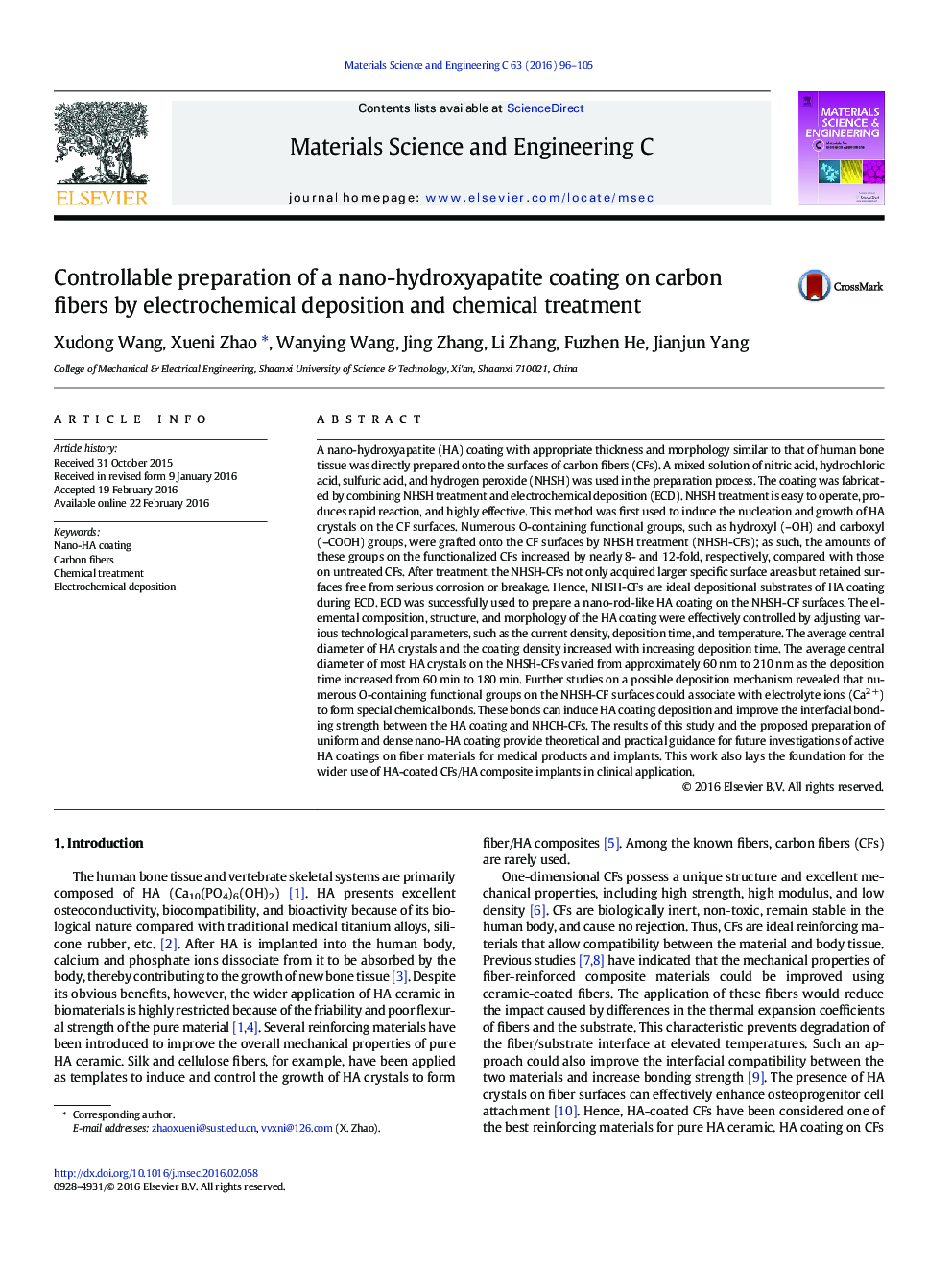| کد مقاله | کد نشریه | سال انتشار | مقاله انگلیسی | نسخه تمام متن |
|---|---|---|---|---|
| 1427998 | 1509158 | 2016 | 10 صفحه PDF | دانلود رایگان |
• The NHSH treatment was the first to be adopted to graft large amounts of O-containing functional groups conducive to hydroxyapatite (HA) deposition on the surfaces of carbon fibers (CF). The possible mechanism of grafting O-containing functional groups on CF surfaces is described in this paper.
• A nano-HA coating with controllable structure, morphology, and thickness was successfully prepared on NHSH-treated CF surfaces by electrochemical deposition.
• A possible deposition mechanism of HA coating involving enrichment of CF surfaces with a large amount of O-containing functional groups (-COOH, -OH, etc.) produced by NHSH treatment is proposed. These O-containing functional groups could attract Ca2+ in the electrolyte to form a special bond and promote the nucleation and growth of HA crystals during electrochemical deposition.
A nano-hydroxyapatite (HA) coating with appropriate thickness and morphology similar to that of human bone tissue was directly prepared onto the surfaces of carbon fibers (CFs). A mixed solution of nitric acid, hydrochloric acid, sulfuric acid, and hydrogen peroxide (NHSH) was used in the preparation process. The coating was fabricated by combining NHSH treatment and electrochemical deposition (ECD). NHSH treatment is easy to operate, produces rapid reaction, and highly effective. This method was first used to induce the nucleation and growth of HA crystals on the CF surfaces. Numerous O-containing functional groups, such as hydroxyl (–OH) and carboxyl (–COOH) groups, were grafted onto the CF surfaces by NHSH treatment (NHSH-CFs); as such, the amounts of these groups on the functionalized CFs increased by nearly 8- and 12-fold, respectively, compared with those on untreated CFs. After treatment, the NHSH-CFs not only acquired larger specific surface areas but retained surfaces free from serious corrosion or breakage. Hence, NHSH-CFs are ideal depositional substrates of HA coating during ECD. ECD was successfully used to prepare a nano-rod-like HA coating on the NHSH-CF surfaces. The elemental composition, structure, and morphology of the HA coating were effectively controlled by adjusting various technological parameters, such as the current density, deposition time, and temperature. The average central diameter of HA crystals and the coating density increased with increasing deposition time. The average central diameter of most HA crystals on the NHSH-CFs varied from approximately 60 nm to 210 nm as the deposition time increased from 60 min to 180 min. Further studies on a possible deposition mechanism revealed that numerous O-containing functional groups on the NHSH-CF surfaces could associate with electrolyte ions (Ca2 +) to form special chemical bonds. These bonds can induce HA coating deposition and improve the interfacial bonding strength between the HA coating and NHCH-CFs. The results of this study and the proposed preparation of uniform and dense nano-HA coating provide theoretical and practical guidance for future investigations of active HA coatings on fiber materials for medical products and implants. This work also lays the foundation for the wider use of HA-coated CFs/HA composite implants in clinical application.
Figure optionsDownload as PowerPoint slide
Journal: Materials Science and Engineering: C - Volume 63, 1 June 2016, Pages 96–105
